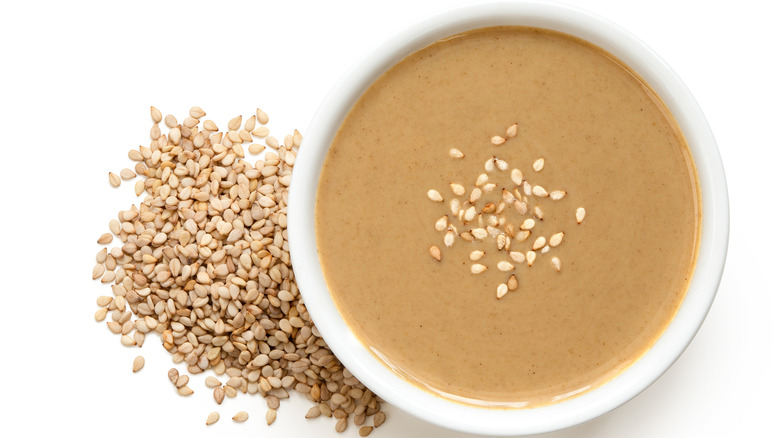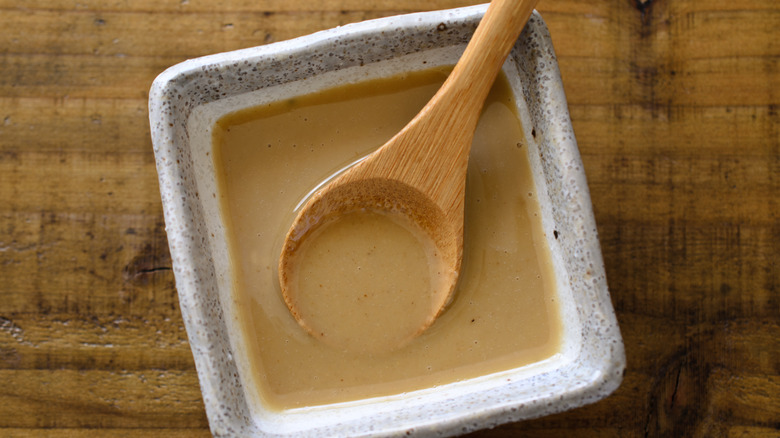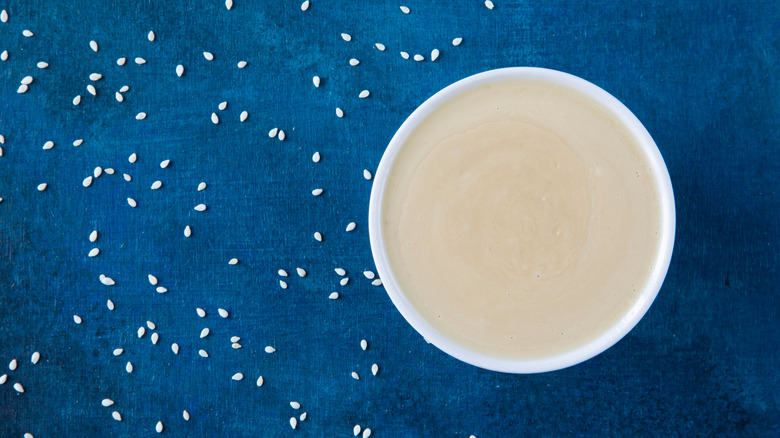Is There A Difference Between Sesame Paste And Tahini?
If you're a fan of the flavor that sesame adds to food, odds are you keep a few different forms of it in your pantry. There are the seeds, the oils, and also the pastes — the latter of which comes in different fashions of its own. If you take a stroll down your local grocery store's international food aisle, you'll be able to spot a couple of them: the Middle Eastern and Mediterranean style known as tahini, and the Chinese style, also called zhi ma jiang (via Plant-Based Wok). Then, over in the peanut butter aisle, you'll find the American version placed somewhere alongside the rest of the alternative nut butters.
Long before its recent adaptation as an allergy-friendly spread on your PB&J, sesame pastes have been used in cuisines around the world. Traced as far back as the 13th century (via Bodrum NYC), Oriental Mart says that sesame seeds originated in Africa or India. Now they're grown in many different parts of the globe and enjoyed in the foods of many more. From Middle Eastern to African and Chinese, and from Japanese and Iranian to Turkish and Korean, the range of cuisines that sesame paste is made and used knows no bounds.
Who knew that a paste made from pure sesame seeds could be reiterated in so many ways? You could spend an entire day researching the differences between each, but this article will address two: Chinese sesame paste and tahini.
What is Chinese sesame paste?
According to Oriental Mart, history isn't exactly clear on when sesame seeds first came to China. But, whether it was 2,000 or 5,000 years ago, one thing is for sure — Chinese sesame paste, or zhi ma jiang, has become a staple in Chinese kitchens and cuisines. However, unlike in Middle Eastern and Mediterranean tahinis, Chinese sesame paste is made using whole seeds that have been toasted. It's also sometimes combined with soybean oil (per Woks of Life). The resulting flavor is much more intense, with a deep color and thick texture comparable to peanut butter. With its unique taste and texture, zhi ma jiang has a range of uses entirely different than tahini.
Due to its rich flavor and intensity, which Taste compared to the taste of fresh pressed sesame oil, zhi ma jiang isn't an ideal substitute for tahini in traditional Middle Eastern or Mediterranean dishes like hummus, nor would it be suitable on your nut-free peanut butter and jelly sandwich. Instead, the robust taste of zhi ma jiang pairs more seamlessly with umami flavors found in savory dishes, and this is why it's often used in dipping sauces and salad dressings along with soy sauce. It's best to stick to adding zhi ma jiang to your Japanese hot pot, mixing it into a bowl of warm sesame noodles, or using it to upgrade your frozen dumplings in a dipping sauce.
How is tahini different?
On the other hand, tahini, the sesame paste traditionally used in Mediterranean and Middle Eastern cuisines, is made from raw sesame seeds (via The Mediterranean Dish). Per the Washington Post, tahini is a key component to good quality hummus. Although the texture and taste range between different types of tahini, most Mediterranean and Middle Eastern restaurants serve it runny so it can be easily drizzled over your plate like a sauce. Bodrum NYC says it will either be used plain or mixed with garlic and lemon juice, with more or less water depending on its use. While you can find different versions of tahini on the market, tahini will usually have a pale color and more mellow flavor compared to Chinese sesame paste.
Even though Chinese sesame paste isn't useful as a substitute for tahini, the same can't be said for the other way around. Yes, tahini is more mellow — but it still has the same sesame flavor and richness (via Splendid Table). If you're preparing a recipe that calls for Chinese sesame paste and you find yourself out or running low, tahini could be a good substitute. But because of its more mild flavor, Taste says that you may want to mix in an extra dash of sesame oil to your recipe for an extra kick. While that mild flavor might seem like a drawback, it's actually what makes it so versatile in many different recipes from tahini chocolate chip cookies to soups and salad dressings.


